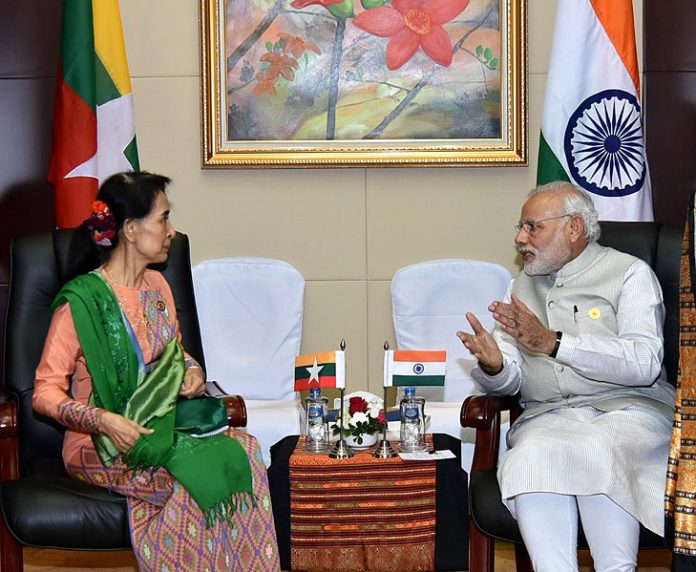In the barren, high altitude Himalayan region between China and India, a clash on June 15 left twenty Indian soldiers dead. Nationalists on both sides called for demonstrations of strength, but cooler heads prevailed. As they de-escalated the conflict at the border, the battlefield shifted to other areas of competition. India, with an economy one-fifth the size of China’s, has struggled to find avenues for inflicting punishment on China. Even among India’s closest allies on the South Asian sub-continent, China has made inroads in recent years. Bangladesh and Nepal responded to June’s border conflict with silence.
In Myanmar, 4000 kilometers east of where the fighting happened, the past two weeks have provided India some much needed good news.
Beijing’s headaches there began on June 24, when a large cache of Chinese-manufactured weapons was seized in Thailand. The weapons were destined for some of the ethnic separatist armies waging war on Myanmar’s military. In the past, Myanmar has been hesitant to criticize China in such instances. It is heavily dependent on China and has little leverage in the relationship.
Last week, however, the government offered an unusually sharp response. General Min Aung Hlaing, Commander-in-Chief of Myanmar’s military, obliquely called China out for interfering in domestic politics. Speaking with Russian state media, Min asked for international help to keep “strong forces” out of Myanmar. “A country may be able to suppress terrorist organizations on its soil. But in cases when there are strong forces behind that terrorist organization, the country alone may not be able to handle it,” he said.
General Min’s statement came four days after he met with Indian Defense Minister Rajnath Singh. The two discussed expanding military cooperation in domains such as counter insurgency, according to a spokesperson for Myanmar’s military. In the context of his meeting with an Indian counterpart, General Min’s statement suggests that India’s support enabled Myanmar to adopt a harder line with Beijing.
For decades, the internationally isolated junta that ruled Myanmar relied on China for military and economic life support. Between 1988 and 2013, when Myanmar had lower imports per capita than North Korea, China provided 42 percent of foreign investment flow into Myanmar and 60 percent of the military’s weapons. “As Western rhetoric in favor of an immediate democratic transition became more shrill, China’s steady declarations of friendship and pledges of ‘non-interference in the internal affairs of Myanmar’ rose in value,” Thant Myint-U, a historian, wrote in his 2011 book Where China Meets India.
China’s promises of non-interference were regularly broken, of course. China backed a communist insurgency in Myanmar throughout the Cold War, and for the last two decades it has supplied weapons and support to Myanmar’s largest ethnic armies, the United Wa State Army. In 2015, the Wa State Army refused to sign a ceasefire, reportedly under orders from Beijing. Myanmar, lacking alternatives, had to accept China’s behavior.
Its options expanded when Indian policy changed. Until the 1990s, India, like most democracies, refused to do business with Myanmar’s ruling junta. It sponsored UN resolutions condemning Myanmar, and Indian Defense Minister George Fernandes even personally allowed exiled Burmese activists to stay in his home.
But as China’s influence among its neighbors grew, so too did Myanmar’s strategic importance to Indian policymakers. India dropped its former intransigence toward the regime, adopting a policy of non-interference. In 2004, India hosted Than Shwe, ruler of the military junta, for a lavish state visit.
Indian Prime Minister Narendra Modi has put Myanmar at the center of efforts to elevate India’s ties with its bordering states and with ASEAN through his Neighborhood First and Act East policies. Myanmar is the only ASEAN nation that enjoys a separate division within India’s External Affairs Ministry, a distinction which testifies to its weight in India’s foreign policy considerations.
While many Western nations put rapprochement with Myanmar on hold after the military forcibly expelled 700,000 people of the Rohingya minority between 2015 and 2017, India has continued to embrace its neighbor. In November 2017, India and Myanmar’s militaries held their first bilateral exercises. Soon after, they launched Operation Sunshine, a joint-military campaign to root out Indian separatist groups based at their shared border. In 2019, they inked a landmark defense agreement that saw Myanmar purchase its first submarine.
India has come under fire for supporting Myanmar’s government. Its most strident critics claim the partnership is ethically compromising while offering “little pay off.” Last week’s events suggest otherwise. A statement from Myanmar’s Commander in Chief lashing out at the interference of “strong forces” might not seem like much. But when compared to the military’s reticence in previous such instances, the statement indicates a notable shift against China.
In Myanmar, India has a partner waiting to be further engaged. Anti-China sentiment is widespread among Myanmar’s military brass, not to its people. General Min’s statement should be read as an invitation for India to provide Myanmar an alternative to widely loathed Chinese support.
For India, this is a rare window of opportunity to chip away at China’s regional position without needing to outspend China. India should double down on its commitment to its eastern neighbor through new economic and military initiatives. Doing so makes China’s missteps into India’s gains. Now is the time for India to act.
The views and opinions expressed in this article are those of the author.

The author is a researcher with the Center for a New American Security’s Asia-Pacific Security Program.


